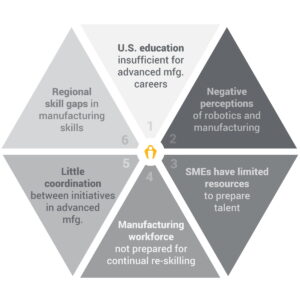
New Monthly Feature: Five Questions
Each month we will interview an expert in the ARM robotics ecosystem on topics of interest to members. This month we are sharing insights on education and workforce training with Lisa Masciantonio, ARM’s Chief Workforce Officer.
What role does education and workforce development (EWD) play in helping to achieve ARM’s mission of growing the use of robotics in U.S. manufacturing?
 Some of the larger barriers to the widespread adoption of robotics are created by systemic workforce development issues. According to a 2018 Deloitte study based on data from the U.S. Bureaus of Labor Statistics and Gallup, the manufacturing skills gap is widening. In 2011, there were 600,000 unfilled manufacturing jobs. This gap is expected to grow to 2.5 million unfilled jobs by 2028. Today, the U.S. manufacturing sector faces a ‘perfect storm’ – nearly 10,000 older workers are retiring each day while several factors reduce the availability of younger workers to take their place. Estimates peg the shortfall at 61% for all workers by 2026.
Some of the larger barriers to the widespread adoption of robotics are created by systemic workforce development issues. According to a 2018 Deloitte study based on data from the U.S. Bureaus of Labor Statistics and Gallup, the manufacturing skills gap is widening. In 2011, there were 600,000 unfilled manufacturing jobs. This gap is expected to grow to 2.5 million unfilled jobs by 2028. Today, the U.S. manufacturing sector faces a ‘perfect storm’ – nearly 10,000 older workers are retiring each day while several factors reduce the availability of younger workers to take their place. Estimates peg the shortfall at 61% for all workers by 2026.
ARM and its member consortium have undertaken substantial efforts to understand the specific robotics workforce challenges faced by industry and to adapt our Workforce Investment Strategy to address those challenges. ARM has identified 6 distinct macro-level workforce challenges necessary for success that can be reasonably addressed through ARM’s developing capabilities and expertise in our member organizations.
The current US educational system (K-12) is insufficient for supporting advanced manufacturing careers. Additionally, K-12 has removed many traditional vocational classes and the current technical courses, fighting an image problem, struggle to attract students. Student exposure to advanced manufacturing careers is minimal, causing a lack of knowledge of what these jobs demand and the educational offerings available to provide the skills needed to succeed in them.
Current negative perceptions of both robotics and manufacturing limit the pursuit of educational and employment opportunities. Manufacturing has a reputation as being dull, dirty, and dangerous and media typically only covers companies that are moving overseas or shutting down. Robots have the reputation of taking away jobs, but that is not always the case – robots bring more advantages than disadvantages to the workplace. The occupations most frequently calling for robotics skills today are Industry 4.0 robotic technicians, robotic specialists, and robotic integrators.
Small and medium-sized manufacturers (SMMs) have limited resources to prepare and develop talent, with little time to train or to allow a worker to train during work hours. In addition to the manufacturing skills gap challenges, the SMMs are also realizing many challenges such as increased regulatory compliance, cybersecurity threats, internet of things and anticipated growth in U.S. manufacturing.
The manufacturing workforce is not prepared for continual re-skilling. Workers of today and the future must always be learning new skills, upgrading competencies, and seeking information on instantaneous platforms. There is an imbalance between large corporations who have extensive training resources as compared to most SMMs who make up most of their supply chain. Therefore, corporate employees are typically up to date and better trained than most workers in SMMs.
There is little coordination across various parties and initiatives in advanced manufacturing. Technologies are evolving so rapidly that coordinated training is difficult to arrange. There are numerous effective training programs and curricula throughout the nation, but there needs to be a way to connect those best practices to fill gaps identified in other locations.
There are substantial regional gaps in manufacturing skills. According to a Deloitte publication on the matter, “Over the next decade nearly 3.5 Million manufacturing jobs need to be filled. The skills gap may leave an estimated 2.4 million positions unfilled between 2018 and 2028.” The only way to fill this many vacant positions, is upskilling underemployed, incumbent workers and widening the net of talent attraction to communities traditionally underrepresented in manufacturing careers: veterans, women, minorities, and disabled.
What has been the focus of the EWD projects to date?
A key element in ARM’s mission is to reinvest into ARM’s ecosystem to address these challenges through the project call process. To ensure that the EWD strategic needs are addressed, ARM provides members with the opportunity to respond to project calls with proposals on prioritized topics that align with these key strategies.
Most of the funding commitment by the Department of Defense (DoD) is invested in formalized projects conducted by teams of ARM members. Project Call topics are generated using a well- defined and highly collaborative process which engages ARM staff, government advisors, and ARM members. The process ensures alignment with ARM’s workforce development mission, targets to improve, and focus areas, and are carefully selected based on their fit with several criteria: institute-specific leverage, impact vs. difficulty, sustainability, and alignment, as described in the Focus Areas for Workforce Development section.
In addition to the funds committed by the DoD, Project Calls are supported by cost share – pledges of support by project participants through their contribution of time, money, or other resources. Cost share is an indication of commitment by project teams to pursue the long-term sustainment and scaling of these initiatives.
In 2019, ARM released its third workforce development Project Call. This project call is different from the previous EWD project calls in that ARM is requesting that bidders collect information around critical data assets. The project results will be housed in an ARM-created online repository to be shared across the ARM Membership, and ultimately the public. This data will inform, create, and refine the ARM Member education and workforce ecosystem. Look for more information on this topic later this summer.
In 2018, ARM released its second workforce development Project Call, further emphasizing ARM’s EWD strategic focus areas and development objectives aligned to work and learn initiatives, while extending into talent attraction as well. The solicitations incorporate specific emphasized talent populations, while leaving others open. As a result, ten projects were awarded.
ARM conducted its first workforce development Project Call in October 2017. As a result, six projects were awarded which focused on apprenticeship programs aimed at benefitting small and medium-sized manufacturers.
What one project would you like to highlight for its current or potential impact on ARM’s mission?
I would like to highlight the 19-03 project call. ARM and our members are actively developing a solution to the workforce challenges I discussed previously, specifically the overall shortage of labor, the lack of standards in roles, and the lack of a nation-wide database where education seekers can gain these skills.
For the past three years, over 200 elite manufacturers, educators, robotics suppliers, economic development and government experts have regularly convened under ARM’s leadership to develop strategies to address the skills gap issue. Our response to this challenge is a public website that addresses these key issues:
- What competencies and roles are required to meet manufacturing employer needs?
- Where can education seekers find programs that best meet these needs?
- What career pathway makes the most sense for me as a job seeker?
- What jobs are available that most closely meet the skills I have developed in robotics and Industry 4.0?
What is one of the biggest challenges that manufacturing employers face when preparing their staff for Industry 4.0 and advanced automation jobs?
The manufacturing industry is currently witnessing the fourth industrial revolution, better known as Industry 4.0. As a result, the traditional manufacturing processes are undergoing an enormous transformation which will change the way companies approach manufacturing and the career pathways for those working in manufacturing. One such change is the introduction of robotics and automation into manufacturing processes.
There are unmet needs in that typical manufacturing companies depend on several resources to understand and integrate robotics, application equipment and various Industry 4.0 technologies. Those resources likely have a vast range of knowledge, skills and abilities and are staffed from different internal departments or from different external sources such as consultants or systems integrators.
Therefore, the skills profile of the manufacturing workforce will undergo a dramatic shift during transition to Industry 4.0, with substantial changes due to increasing use of robotics and automation. Overall, this shift is expected to lead to nearly a million new jobs by 2025.
The skills required for these jobs are necessarily quite different than those needed in the current workforce. There will be a substantial demand for so-called “Adaptive skills”, including complex problem-solving skills used to solve novel, ill-defined problems, and systems skills to allow workers to understand, monitor, and improve systems.
What are some of the things that ARM is doing or plans to do to help with the challenge defined in #4?
In response to the six workforce challenges, ARM has been working with our members to translate them into clear, actionable, and measurable goals. ARM’s interpretation of the challenges manifested itself in the clear but challenging workforce development goal of expanding the size, diversity and skill set of the United States robotics workforce.
